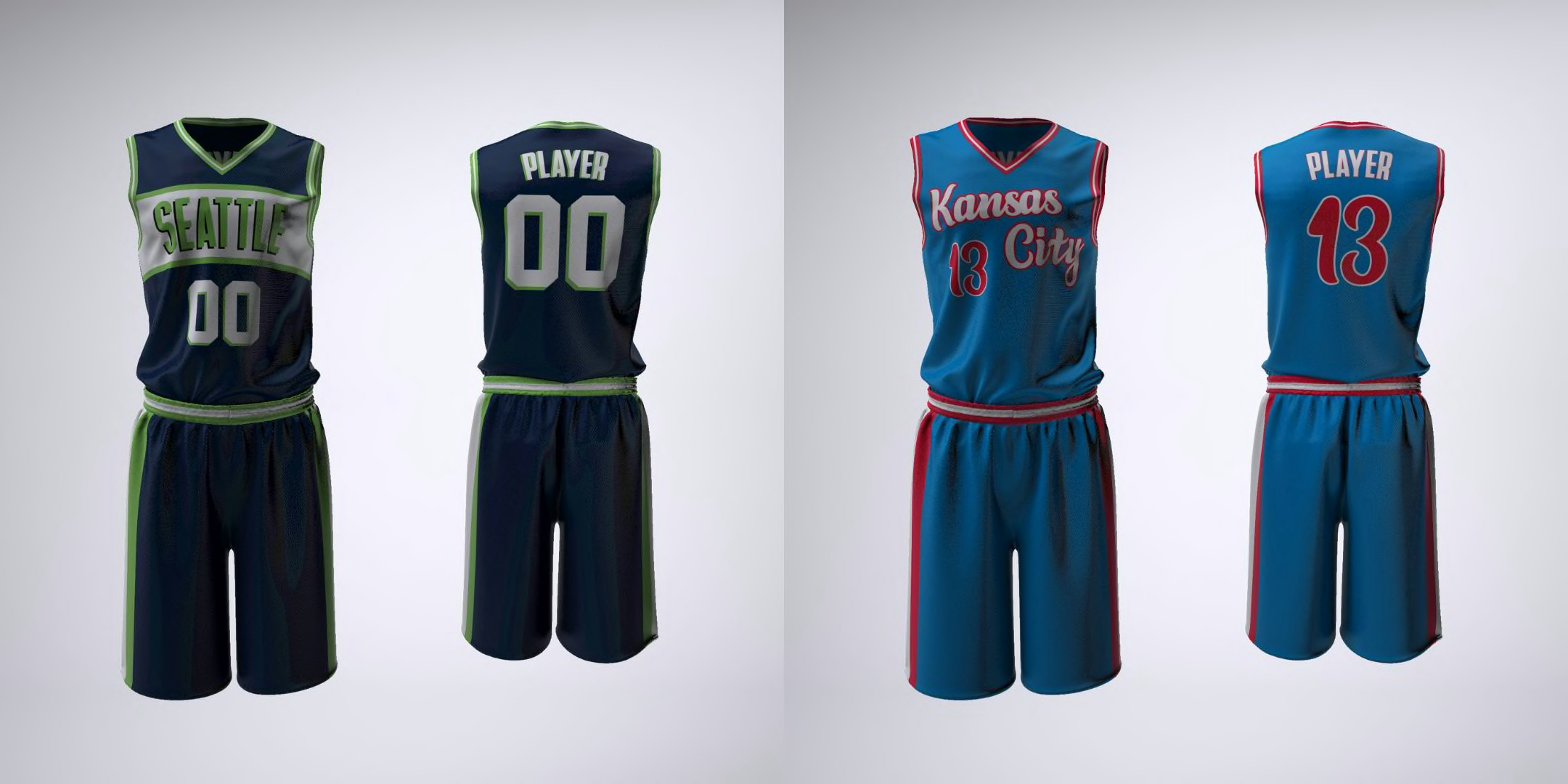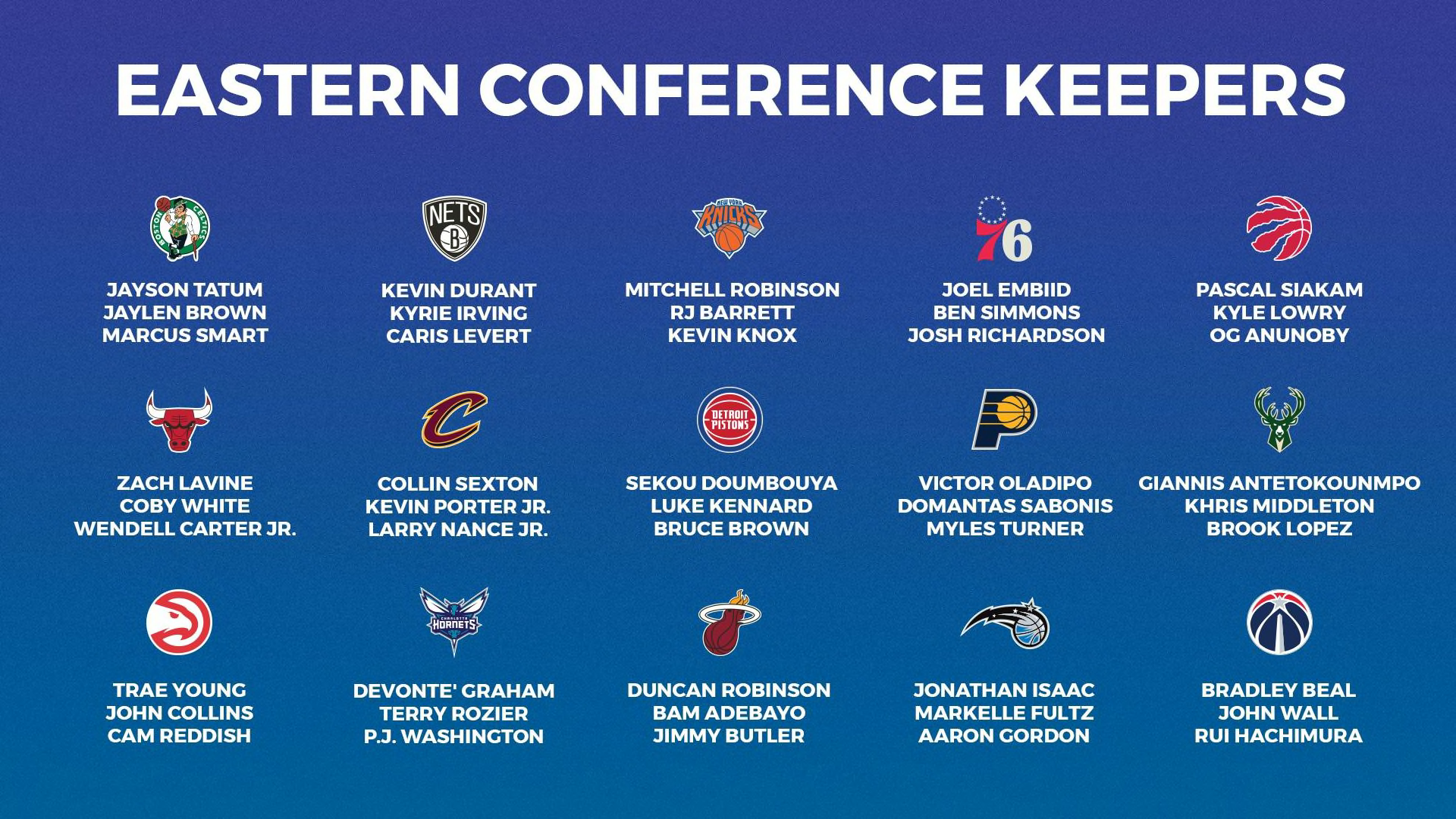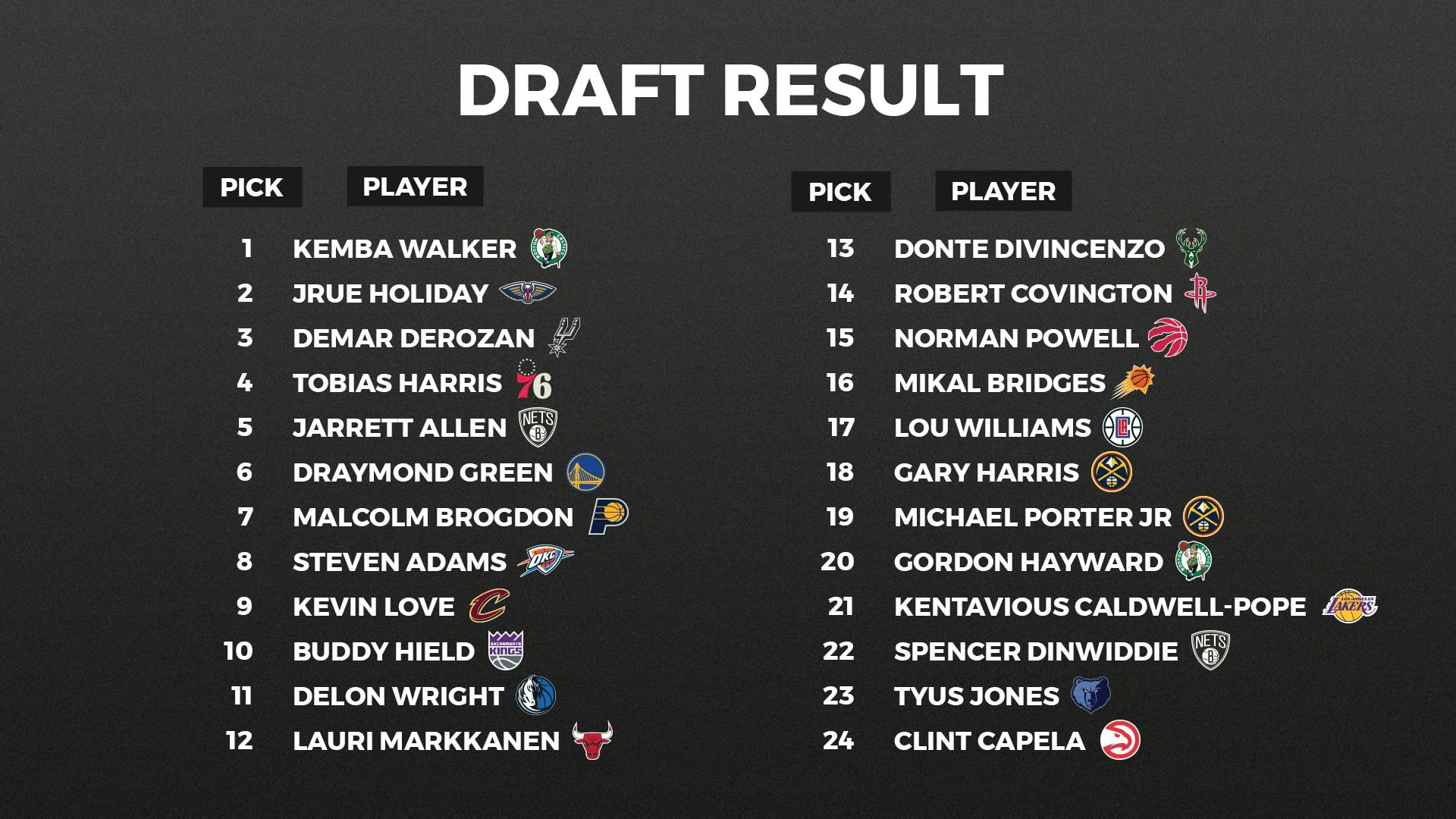What would it look like if the NBA added two new franchises and held an NBA Expansion Draft, one optimized for maximum chaos?
The return of the NBA season is inching closer but for much of the past four months, it was far from certain. In the immediate window after the season was suspended, it seemed like everyone was exploring ways to hold onto basketball without, you know, actually having basketball. (Remember when we all watched Kevin Durant and Derrick Jones Jr. on ESPN, playing NBA2K in silence?)
Somewhere in that dark well of uncertainty, our NBA Editorial Director, Josh Wilson, approached me with the idea of running an NBA Expansion Draft. With actual NBA basketball just two weeks away, the hard left turn into fantasy and hypothetical seems a little less relevant but it turns out building two professional sports franchises from scratch (even imaginary ones) takes time. FanSided graphic designer Anthony Guagliardo put together some sparkling logo and uniform designs for us and we pulled in some help to run the draft and assemble the rosters.
We had a blast putting this all together and we hope you dig it too. If not, don’t worry. On July 30, you can get back to watching real NBA basketball again. For now, meet the Kansas City Burnt Ends and the Seattle Sea Lions.


— Ian Levy (@HickoryHigh)
The rules
In trying to find a balance between encouraging chaos and maintaining some level of plausibility, we settled on letting each current franchise protect three players from our expansion draft. We turned to the excellent site experts in our NBA network to make the protections for each team.
From there, we assembled a player pool and handed our two expansion franchises to FanSided editor Gerald Bourguet (@GeraldBourguet) and Hoops Habit site expert Duncan Smith (@DuncanSmithNBA) and asked them to develop a strategic vision for the new teams and build out their rosters in the draft.
The rules for the draft were:
- Each expansion team will select a minimum of 14 players who are under contract or restricted free agents for the 2020-21 season. We assumed all player and team options would be picked up so those players would need to be protected.
- Each expansion team may select no more than one player from each existing team.
- Each expansion team can only select players that are left unprotected by an NBA team. No free agents.
- Each of the 30 NBA teams may protect a maximum of three players on its roster who are under contract or are restricted free agents at the conclusion of the 2020-21 season.
The player pool

The player protections in the Western Conference went about as expected, although there were a few surprises. Blue Man Hoop opted to keep Andrew Wiggins over Draymond Green, since there’s almost no way Green wouldn’t have been selected in the expansion draft. It was comforting to see Air Alamo lean into the rebuild, prioritizing young players over veterans.

There were several tough decisions to be made in the Eastern Conference — particularly for Hardwood Houdini, who left both Gordon Hayward and Kemba Walker unprotected. King James’ Gospel also opted for the steady presence of Larry Nance Jr., leaving veteran Kevin Love and last year’s lottery pick Darius Garland unprotected. For Nothin’ But Nets, the upside of Caris LeVert is clearly too good to pass up, but leaving Jarrett Allen and Spencer Dinwiddie open has to hurt.
With the protected players locked in, here are some of the most intriguing players who were left available for the expansion draft.

The pool of available players includes several big names as well as three players who averaged at least 20 points per game this season (Kemba Walker, DeMar DeRozan, Spencer Dinwiddie), a former Defensive Player of the Year (Draymond Green) and nine others (Walker, DeRozan, Green, LaMarcus Aldridge, Nikola Vucevic, Blake Griffin, Andre Drummond, Kevin Love, Al Horford) who made in All-Star team in the last three seasons. Where did all that talent end up?
The draft

Duncan, representing the Kansas City Burnt Ends, won the first pick in a coin flip and took Kemba Walker. Gerald, representing the Seattle Sea Lions went second and took Jrue Holiday. Walker and Holiday were obvious as the first two picks, putting in place offensive foundations and ball-handlers to build around. From here it was interesting to see who prioritized what skills and positional groups, as well as a bit of gamesmanship around the rule of each expansion franchise only being able to select one player from each team (more on that below).
As far as surprises, there were not a ton but a focus on specific skill sets and avoiding positional overlap meant several talented players — Nikola Vucevic, Eric Bledsoe, Al Horford, Andre Drummond and Patrick Beverley — went undrafted.
The teams

The draft strategy was just as much about the players the other expansion team was picking as it was about my own. Since we were only allowed to pick one player each from any NBA team, that meant that as soon as Kemba Walker was taken, I knew Gordon Hayward (or any other Boston Celtic in the pool) would still be available at the end. In other words, I could save Hayward for the later rounds and address more pressing needs first. The same went for Spencer Dinwiddie and LaMarcus Aldridge, a player who was considered for Seattle’s final pick but ultimately just missed the cut — as soon as Kansas City took Jarrett Allen and DeMar DeRozan, I knew I could save guys who were already on my draft board for later.
With that in mind, I had Hayward, Dinwiddie and Aldridge tentatively marked down for my last three picks. With Kemba going No. 1, Jrue Holiday was an easy choice for Seattle’s starting backcourt as a two-way stud who’s still only 30 years old. Tobias Harris, who’s only 27, locked in some scoring and potential for growth.
Draymond Green was my third pick, and though that seems high, he’s the defensive linchpin that unlocks a plethora of lineups for Seattle. People are down on Green after he “dialed it in” this season for the Golden State Warriors, but we’re not going to hold dwindling numbers on a tanking team against him. Had the Dubs been healthy, we would’ve seen the same defensive force he’s been for five Finals teams, albeit slightly less athletic. Let’s not write him off yet when he only just turned 30.
As a stout, defensive-minded big man who can pass and doesn’t need a lot of touches, the 26-year-old Steven Adams was the perfect starting center. Because there wasn’t much 3-point shooting on the roster so far, Buddy Hield (a career 41.1 percent long-range sniper on 6.7 attempts per game) rounded out the starting five.
Finding a long-term replacement for Green at the 4-spot became the next priority. He’s not much of a rebounder or a defender, but Lauri Markkanen was too good to pass up here, especially since he could come in off the bench and provide the shooting that Green can’t. He’s probably miscast as the face of a franchise in Chicago, but at only 23 years old, he’d have room to grow on a playoff team without being expected to carry the new Sea Lions.
With the starting five set, Markkanen as a backup stretch-4 and Dinwiddie being saved for later as the backup 1, the draft focus switched to finding the right wing depth. Robert Covington was the first guy that came to mind as a versatile, defensive stopper. Although his 3-ball has been unreliable over the last few years, he’s respectable enough to spread the floor and his ability to guard positions 2-5 is a major boost. Drafting Mikal Bridges — one of the most underrated, already elite defenders in the NBA who’s finally starting to hit 3s at a more respectable rate and won’t turn 24 until August — right after makes for a juicy mentor-mentee situation with RoCo, especially since Bridges as a small-ball 4 unlocked Phoenix’s most effective five-man lineup this year.
That left one more pick before the last three selections I had planned out. Call me crazy, but I still believe in Gary Harris — especially for an eighth-round pick in this draft. He’s only shot about 33 percent from deep the last two seasons and he’s barely been on the court due to injury, but he’s still only 25 and it wasn’t long ago that he was considered one of the NBA’s brightest 3-and-D guards. Even if he can’t stay healthy, there’s more than enough depth to compensate. From there I took Hayward to round out a feisty group of two-way wings, followed by Dinwiddie to add to the team’s length and versatility at the backup point guard spot.
The last pick came down to two frontcourt players I had on my board from the beginning: LaMarcus Aldridge and Clint Capela. Aldridge is clearly the better player, but he’s also 34 and his numbers have slightly dipped over the past two seasons. With Green, Markkanen and Adams in the frontcourt, the short-term upgrade wasn’t worth the rim protection, alley-oop threat and long-term upside of Clint Capela, who’s only 26 and could learn about positional defense from Adams.
While the Sea Lions lack a designated superstar who can take over games, that is a damn formidable rotation that can play both ends of the court and mix and match lineups to the head coach’s liking. That coach would be Kenny Atkinson (because let’s face it, the New York Knicks are going to screw this up somehow), and he’d have more than enough shooting, positional versatility and defense to give any superstar-driven team a run for its money. Even better, not a single player on Seattle’s roster is over the age of 30, setting this group up for short-term success and long-term growth — just what any expansion NBA team could ask for.
— Gerald Bourguet (@GeraldBourguet)

Building an expansion team from a pool of players made up of the fourth-and-lesser players on each team in the NBA made for a unique challenge. First off, you don’t have the opportunity to select any game-changing stars, but you do have the opportunity to construct for depth and versatility by selecting players who might flourish when made a first, second or third option on offense rather than a third, fourth or five option.
While most teams in the NBA do have rosters that are top-heavy and the bottom couple of players are indeed the bottom couple of players, I wanted to build a team that could conquer its own top-level talent deficiency with versatility and the ability to match up with a variety of opponents. Having access to a pool of players who would be between the fourth and seventh-best players on most teams made that possible.
My main goal was to not constrain my team to certain mediocrity as an expansion franchise. I wanted to embrace some variance in the hopes that a team constructed in this fashion could at least make top teams work for their eventual wins.
I wanted to focus on scoring primarily with stars like Kemba Walker and Kevin Love who can score from wherever they want, and an automatic bucket-getter in DeMar DeRozan who is deadly from anywhere inside the 3-point line. Lou Williams will be a high-volume lights-out scorer off the bench.
Malcolm Brogdon is another lethally effective scorer who can function well as a tertiary option in addition to his own positional versatility being able to play either guard spot and occasionally feature on the wing. Delon Wright, Donte DiVincenzo and Norman Powell are all players who can combine shooting with athleticism and energy, and can play multiple spots on the floor as well.
In addition, Brogdon, DiVincenzo and Kentavious Caldwell-Pope all provide effective 3-and-D production and can match up with a wide variety of wings and guards to stifle their offense.
From the perspective of the frontcourt, we’re a bit thin. Having chosen guard and wing versatility over everything, we’re hoping the Houston Rockets small-ball experiment works out because this team is just a bit bigger than that squad.
Of course, Kevin Love provides offense and rebounding, and Jarrett Allen is one of the best young centers in the NBA, but there isn’t much behind them. Michael Porter Jr. is talented but raw and unproven and struggled to stick in the rotation at times for the Denver Nuggets. He’ll be needed to contribute reliably on this roster, but he was a steal in the 10th round of the expansion draft.
Finally, while veteran contributions are going to be key in the first season for this franchise, I also drafted with an eye towards the future with guys like Allen, Porter and DiVincenzo, all players under the age of 24 years old.
While this roster certainly isn’t a championship contender, and at least in year one will cap out battling for a mid-tier playoff spot, perhaps down the road, these youngsters can be the core of a team that can contend for an NBA title, building upon the foundation set here.
As we stand now, my expected starting lineup would consist of Kemba Walker and Malcolm Brogdon in the backcourt, DeMar DeRozan playing the three, and Kevin Love and Jarrett Allen would round out my frontcourt.
— Duncan Smith (@DuncanSmithNBA)